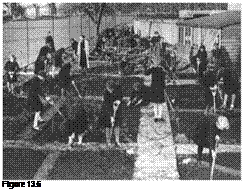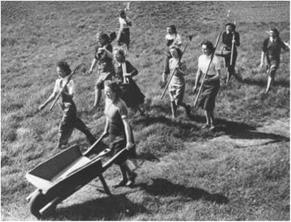 In Britain, the end of the ‘Dig for Victory’ campaign was followed by a sharp decline in urban food production. Throughout the 1950s and 1960s, a great deal of food growing land was returned to its original pre-war use or lost to new development. The combined effect of the new welfare state, effectively full employment and increasing prosperity meant that people no longer saw a need to grow their own food. Furthermore, allotments suffered from an image problem: they were associated with wartime austerity and ‘make do’ and certainly did not chime with the spirit of an age dedicated to scientific progress and youth culture.
In Britain, the end of the ‘Dig for Victory’ campaign was followed by a sharp decline in urban food production. Throughout the 1950s and 1960s, a great deal of food growing land was returned to its original pre-war use or lost to new development. The combined effect of the new welfare state, effectively full employment and increasing prosperity meant that people no longer saw a need to grow their own food. Furthermore, allotments suffered from an image problem: they were associated with wartime austerity and ‘make do’ and certainly did not chime with the spirit of an age dedicated to scientific progress and youth culture.
To address the issues surrounding the decline in allotment use, the incoming Wilson Government set up an inquiry chaired by Professor Harry Thorpe in
|
Figure 13.6 Children digging in their school’s vegetable garden. Figure 13.7 Girton college students during the Second World War.
1964. Thorpe appreciated the value of allotments, but was deeply critical of the allotment movement as a whole. He believed that the best hope of allotment survival in the affluent new age lay in re-creating them as ‘leisure-gardens,’ which avoided the charitable associations of the term ‘allotment.’ Thorpe also observed that the legislation surrounding allotments was highly confusing. Amongst his 44 recommendations, he called for a new allotment Act to rationalise the law. However, to date, none of Thorpe’s recommendations have been taken up by government. Thorpe’s proposals are by no means universally admired (see Chapter 15), critics arguing that one of the consequences of adopting them would have been to deny the informal and self-directed use of allotments, which is essential to their character and function in the city. But to deny the positive aspects of Thorpe’s recommendations is equally short-sighted. Indeed, the observations made by the authors, of layers of occupation at the Moulsecoombe allotment near Brighton (see Chapter 19) show how allotments are already being used for leisure. If we think of allotments as one component of productive urban landscape, set within continuous landscape, then Thorpe’s leisure concepts may be seen as prompts for a new understanding of leisure landscapes.




